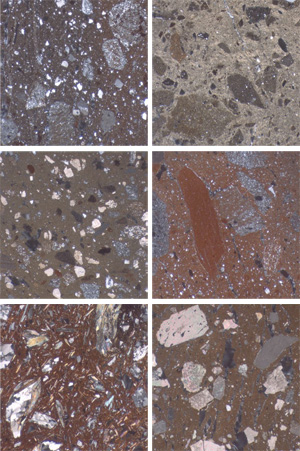Ελληνικά

under the aegis of the Canadian Institute in Greece and the Hellenic Ministry of Culture

Thin sections of ASP prehistoric pottery. Photographs by A. Pentedeka.
Particularly with regard to the less easily identified, earliest periods of human activity on the island, we have sought to complement macroscopic analysis of our survey pottery, with microscopic petrographic methods. Inspired by the success of similar approaches on neighbouring Kythera (for further details), ASP has placed great emphasis on close integration between the initial identification of macroscopic fabric groups by Lindsay Spencer (UCL), her selection of potentially informative 'index' sherds for sampling and the resulting programme of petrographic analysis by Areti Pentedeka and Evangelia Kiriatzi (Fitch Laboratory, British School at Athens). This combined approach is important not only for dating purposes, but also for placing our pottery sequence in the broader context of the south-west Aegean. More precisely, it offers insights in three main ways:
- verifying the reality of macroscopically identified fabric groups;
- identifying the major mineralogical components of each fabric group in order to determine their compatibility with local geologies or to suggest their off-island origin, and
- exploring variation within these fabric groups stemming from production decisions. At a broader level, this allows us to explore on-island potting strategies and to trace changing patterns of interaction between Antikythera, Kythera, the mainland and Crete during the Bronze Age, for which there is a growing set of comparable petrographic data.
A total of 175 samples were chosen for petrographic characterisation from the wider assemblage of ASP prehistoric pottery. All samples were subjected to petrographic analysis by thin section microscopy (using a Leitz Laborlux 12 POL polarising microscope), in order to facilitate mineralogical characterisation; to explore the technological recipes used for clay paste preparation and processing (i.e. clay tempering and/or mixing, firing temperatures), and potentially to define the geographical provenance of each fabric. Important comparisons between ASP material and that from neighbouring regions is also made possible due to important comparative reference collections from Kythera and west Crete that are housed in the Fitch Laboratory.
In addition to the thin section analysis, each sample was also refired at 1000oC in oxidising conditions using a Naberthem L5/P furnace. This temperature was considered to be well above the firing temperatures of the pottery under study (according to the initial thin section examination) and, by eliminating the variation in clay colour caused by ancient firing conditions, allows us to develop a standardised comparison of fired clay colours as an adiditonal perspective on issues of fabric variability and perhaps geographical provenance.